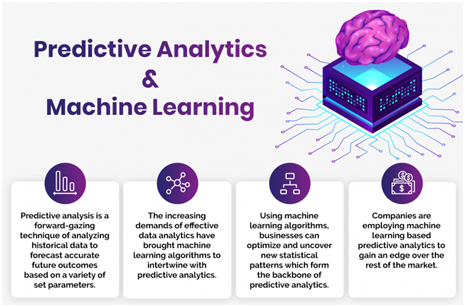2 min read
Predictive Analytics and its relation to Machine Learning
Anurag : Aug 6, 2020 1:42:00 PM

Predictive analytics is a branch of advanced analytics that helps in making predictions about future events. It encircles data mining, statistics, machine learning, artificial intelligence, Etc. It basically uses historical data to predict future events and suggest actions for optimal outcomes.
Benefits of Predictive Analytics:
- Enhanced Fraud Detection.
- Enhanced Risk Reduction.
- Improved Decision-Making.
- Competitive Differentiation.
- Optimizing Marketing Campaigns.
- Merchandise Planning and Price Optimization.
Accurate and efficient predictive analytics takes some upfront work to set up. It requires people who understand there is a business problem to be solved, collect the necessary data, and can further analyze it, models that need to be built and refined, and leadership to put the predictions into action for positive outcomes. The designed model for predictive analytics should eventually be able to identify patterns and trends about your customers and their behaviors. One can also run one or more algorithms and pick the one that works best for your data or could opt to collect a group of these algorithms. Though the trends and patterns will inevitably fluctuate based on the time of year, what activities your business has underway, and other factors. Set a timeline, maybe once a month or once a quarter—to regularly retrain your predictive analytics learning module to update the information.
All companies can make most of it from using predictive analytics to gather data on customers and predict the next actions based on historical behavior. This information can further cast-off to make decisions that impact the business’s bottom line and influence the results thereof.

Predictive analytics and machine learning
Every business wants to grow but, the only handful of companies actualizes this vision and does it through data-based decision making. In order to make informed decisions, companies have been using machine learning and predictive analytics.
Machine learning is an AI technique where the algorithms are given data and asked to process without a predetermined set of rules and regulations whereas; Predictive analysis is the analysis of historical data as well as existing external data to find patterns and behaviors. In the present era, predictive analytics extensively uses machine learning for data modeling due to its ability to accurately process vast amounts of data and recognize patterns.
Machine-learning based predictive analytics are being used by many industries in order to achieve positive results. Elucidated below are some of the use of machine learning-based predictive analysis:
- E-commerce: In order to understand the customers' preference and their behavior in a better way companies are using machine learning algorithms to study the browsing pattern of the customers and also give personalized suggestions to its customers. It also helps in managing the supply-chain process and inventory.
- Customer Service: The primary goal of predictive analysis is to provide superior customer service. Machine learning-based predictive analytics helps the companies to segregate the customers based on their buying pattern, taste & preference, etc.
- Sales and Marketing: Machine learning-based predictive analytics helps the companies to identify and acquire prospects with similar attributes to existing customers.
- Financial Services: Most of the finance companies rely on intelligent algorithms and analytics to detect and prevent fraudulent transactions and activities. It scans historical datasets and identifies risk areas so that companies can make decisions to avoid risks.
Conclusion
Organizations are employing predictive analytics and machine learning to gain an edge over the market. It helps them to discover the hidden patterns of the unstructured data sets and reveal new information.
The future of CRMs
CRM (Customer Relationship Management) is as of now amidst an intellectual transformation, and in the coming years, we won't consider Machine Learning


